 United Kingdom (1889) HMS Blake, Blenheim
United Kingdom (1889) HMS Blake, BlenheimWW1 RN Cruisers
Blake class | Edgar class | Powerful class | Diadem class | Cressy class | Drake class | Monmouth class | Devonshire class | Duke of Edinburgh class | Warrior class | Minotaur classIris class | Leander class | Mersey class | Marathon class | Apollo class | Astraea class | Eclipse class | Arrogant class | Highflyer class
Pearl class | Pelorus class | Gem class | Forward class | Boadicea class | Blonde class | Active class | Bristol class | Weymouth class | Chatham class | Birmingham class | Birkenhead class | Arethusa class | Caroline class | Calliope class | Cambrian class | Centaur class | Caledon class | Ceres class | Carlisle class | Danae class | Cavendish class | Emerald class
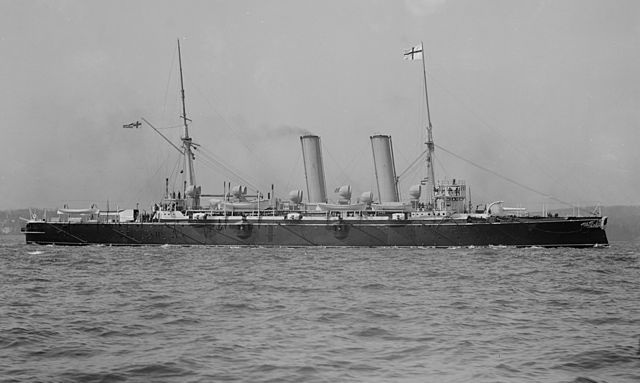
HMS Blake in the 1890, in typical peacetime livery, black hull, white superstructures and canvas sand funnels, masts and apparels.
The oldest cruisers in British service
In 1914 indeed, the oldest 1st class cruisers in service were the two Blake, designed by William White from Chatham Dyd. They were not a clear departure over the previous Orlando class at least in terms of armament and general layout but varied in many details and showed the way for the decade to come. They preceded the Edgar class. Due to their age, however, both were partially disarmed and converted as depot ships from 1907 so their “participation” in WW1 was all but symbolic.
⚠ Note: This old post is scheduled for rewriting. Completion expected later in 2025.
❯❯❯❯❯❯❯❯❯❯❯
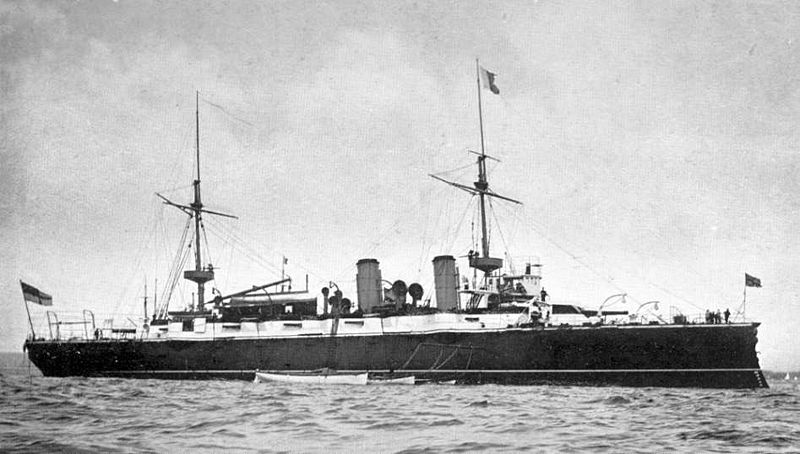
The previous Orlando class
Design similarities and differences with the Orlando class
The 1886, 5600 tonnes Orlando would be not treated as part as the RN in ww1 (so postponed for an industrial era extension in future years) since all were discarded and sold before the war broke out in 1905-1907. These seven ships made for overseas stations, Australia, the Mediterranean, and China, were capable of 17 knots, and carried two 9.2 in (234mm) breech-loading guns, but mostly relied on ten 6in (152 mm) to do the bulk of the gunnery, although themselves were Breech-loading, therefore slow to load. All these guns were under masks, the 6in having some very long and roomy, almost turrets without backs, while the QF artillery of 6 and 3 pdr were all in barbettes and tops to deal with TBs.
The two Blake were almost twice larger (9150 tonnes) longer, wider, and more than double the power and the coal supply to match, plus a rethought protection. They were in fact the largest cruisers built at that time. The HMS Blake was laid down in July 1888, launched 23.11.1889, completed 2.2.1892 and her sister-ship built at Thames Iron Works, Blackwall, was laid down in october 1888, launched 5.7.1890 and completed in 26.5.1894.
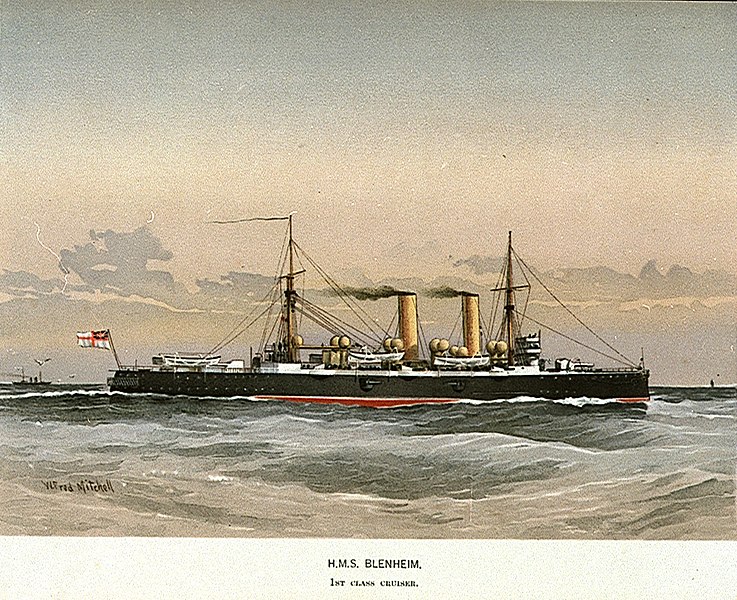
Painting of HMS Bleinheim at sea
Their main feature was a full length protective deck, thicker (3-6 in instead of 2-3 in) while her gunshields were 4-1/2in, casemates 6in and conning tower 12in (305 mm) while on the Orlando the bulkheads were 16in thick (380 mm) and the belt 10in. White’s design provided the Royal Navy with a “true” first class cruiser, much faster (20 knots) and with much more autonomy, seakeeping, and combination of armament of protection which fit the Admiralty bill for a long-range trade protection and fleet cruiser.
The fastest cruiser so far
While more than doubling the powerplant, horsepower also more than doubled, leading to a net gain of three knots. It seems not a lot for such power debauchery, but the displacement also almost doubled at the same time. Long story short, the Blakes had 2 shafts, each moved by two 3-cylinder triple expansion steam engines fed by 8 coal-firing boilers which produced 13,000 ihp (9,700 kW) in natural draught, and 20,000 ihp (15,000 kW) in forced draught, resulting in a top speed of 20 knots (37 km/h; 23 mph) in natural draught, and 22 knot (41 km/h; 25 mph) on trials and forced draught. Coal capacity was 1800 tons, allowing for a much longer range, but less than expected: 10,000 nautical miles (19,000 km; 12,000 mi) at 10 knots (19 km/h; 12 mph) instead of the 15,000 nautical miles (28,000 km; 17,000 mi) planned.
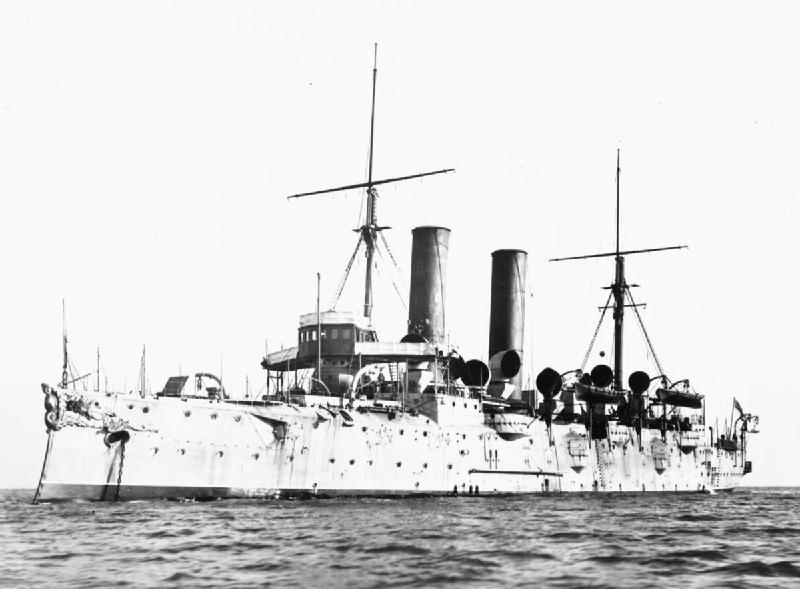
HMS Bleinheim before 1914, with a white hull livery – collections of the Imperial War Museums
Armament
Armament still remains close to that of orlando, but with a better distribution for defence against medium calibers. In particular two of the 6 in guns in side casemates were moved to the main deck and armoured casemates were generalized, which became White’s trademark for following ships.
Career
Both ships were built at Chatham Dockyard and Thames Ironworks respectively,the lead ships costing £440,471, usually more than her sister ship at £425,591. Blenheim was only commissioned in 1894. Blake became the flagship of NAWI station in 1892-95, then the Channel fleet until 1898 while Bleinheim, which also served there was versed to the China station in 1901 until 1904. In 1907 both ships were considered obsolete and partially disarmed to be converted as depot ships.
Despite of this HMS Blenheim had the more active career, supporting the Mediterranean Expeditionary Force at the Battle of Gallipoli and carrying back home Prince Henry of Battenberg, former Canadian Prime Ministers Sir John Thompson and Sir Charles Tupper. Blake was sold for scrap in 1922and Bleinheim in 1925.
Specifications |
|
| Dimensions | 121.84 x 114.30 x 19.81 m (399 x 375 x 65 ft) Draught 7.32 m (24 ft) |
| Displacement | 9,150 long tons (9,300 t) FL |
| Crew | 570 |
| Propulsion | 2 shafts, 3 cyl TE steam engines, 8 boilers 13,000 ihp (9,700 kW) (20,000 forced) |
| Speed | 20 kn (37 km/h; 23 mph) natural, 22 kn forced draught |
| Armament | 2 × 234mm Mk VI, 10 × 152 mm QF, 16 × 47 mm Hotchkiss QF, 4 × 356 mm TTs (BL 9.2-inch, QF 6-inch, QF 3-pounder, 14-inch TTs) |
| Armor | Decks 76–152 mm, gunshields 110 mm, Conning tower 300 mm (3–6 in, 9.2 in, 4.5 in CT 12 in) |

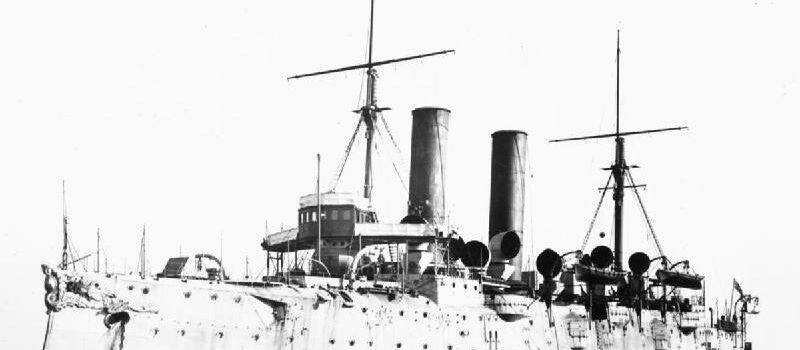
 Latest Facebook Entry -
Latest Facebook Entry -  X(Tweeter) Naval Encyclopedia's deck archive
X(Tweeter) Naval Encyclopedia's deck archive Instagram (@navalencyc)
Instagram (@navalencyc)





 French Navy
French Navy Royal Navy
Royal Navy Russian Navy
Russian Navy Armada Espanola
Armada Espanola Austrian Navy
Austrian Navy K.u.K. Kriegsmarine
K.u.K. Kriegsmarine Dansk Marine
Dansk Marine Nautiko Hellenon
Nautiko Hellenon Koninklije Marine 1870
Koninklije Marine 1870 Marinha do Brasil
Marinha do Brasil Osmanlı Donanması
Osmanlı Donanması Marina Do Peru
Marina Do Peru Marinha do Portugal
Marinha do Portugal Regia Marina 1870
Regia Marina 1870 Nihhon Kaigun 1870
Nihhon Kaigun 1870 Preußische Marine 1870
Preußische Marine 1870 Russkiy Flot 1870
Russkiy Flot 1870 Svenska marinen
Svenska marinen Søværnet
Søværnet Union Navy
Union Navy Confederate Navy
Confederate Navy Armada de Argentina
Armada de Argentina Imperial Chinese Navy
Imperial Chinese Navy Marinha do Portugal
Marinha do Portugal Mexico
Mexico Kaiserliche Marine
Kaiserliche Marine 1898 US Navy
1898 US Navy Sovietskiy Flot
Sovietskiy Flot Royal Canadian Navy
Royal Canadian Navy Royal Australian Navy
Royal Australian Navy RNZN Fleet
RNZN Fleet Chinese Navy 1937
Chinese Navy 1937 Kriegsmarine
Kriegsmarine Chilean Navy
Chilean Navy Danish Navy
Danish Navy Finnish Navy
Finnish Navy Hellenic Navy
Hellenic Navy Polish Navy
Polish Navy Romanian Navy
Romanian Navy Turkish Navy
Turkish Navy Royal Yugoslav Navy
Royal Yugoslav Navy Royal Thai Navy
Royal Thai Navy Minor Navies
Minor Navies Albania
Albania Austria
Austria Belgium
Belgium Columbia
Columbia Costa Rica
Costa Rica Cuba
Cuba Czechoslovakia
Czechoslovakia Dominican Republic
Dominican Republic Haiti
Haiti Hungary
Hungary Honduras
Honduras Estonia
Estonia Iceland
Iceland Eire
Eire Equador
Equador Iran
Iran Iraq
Iraq Latvia
Latvia Liberia
Liberia Lithuania
Lithuania Mandchukuo
Mandchukuo Morocco
Morocco Nicaragua
Nicaragua Persia
Persia San Salvador
San Salvador Sarawak
Sarawak Uruguay
Uruguay Venezuela
Venezuela Zanzibar
Zanzibar Warsaw Pact Navies
Warsaw Pact Navies Bulgaria
Bulgaria Hungary
Hungary

 Bundesmarine
Bundesmarine Dutch Navy
Dutch Navy Hellenic Navy
Hellenic Navy Marina Militare
Marina Militare Yugoslav Navy
Yugoslav Navy Chinese Navy
Chinese Navy Indian Navy
Indian Navy Indonesian Navy
Indonesian Navy JMSDF
JMSDF North Korean Navy
North Korean Navy Pakistani Navy
Pakistani Navy Philippines Navy
Philippines Navy ROKN
ROKN Rep. of Singapore Navy
Rep. of Singapore Navy Taiwanese Navy
Taiwanese Navy IDF Navy
IDF Navy Saudi Navy
Saudi Navy Royal New Zealand Navy
Royal New Zealand Navy Egyptian Navy
Egyptian Navy South African Navy
South African Navy






























 Ukrainian Navy
Ukrainian Navy dbodesign
dbodesign